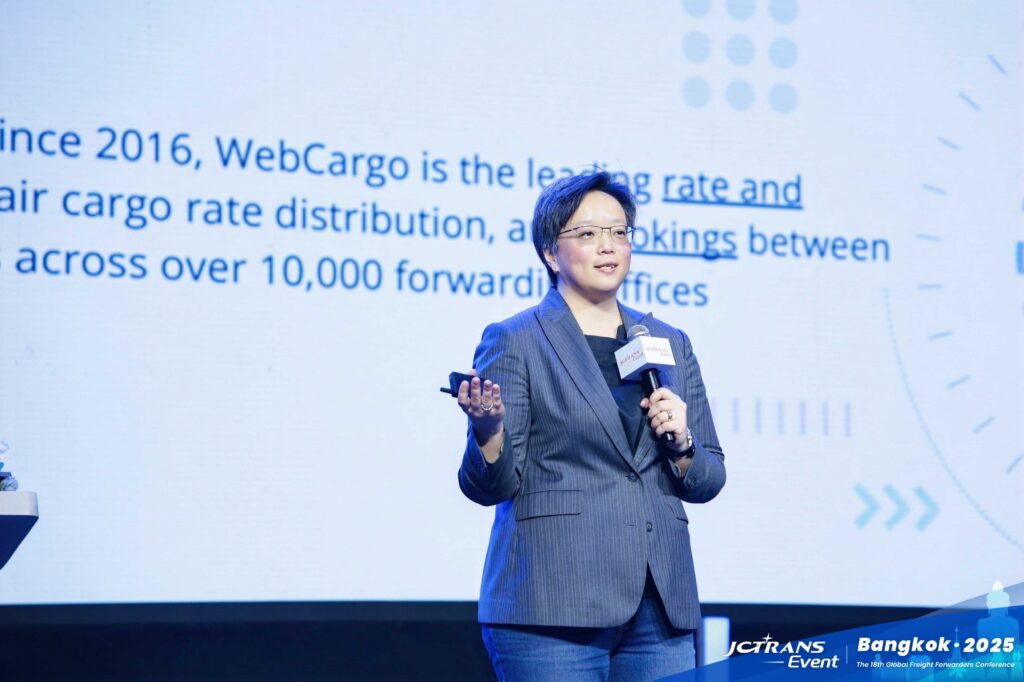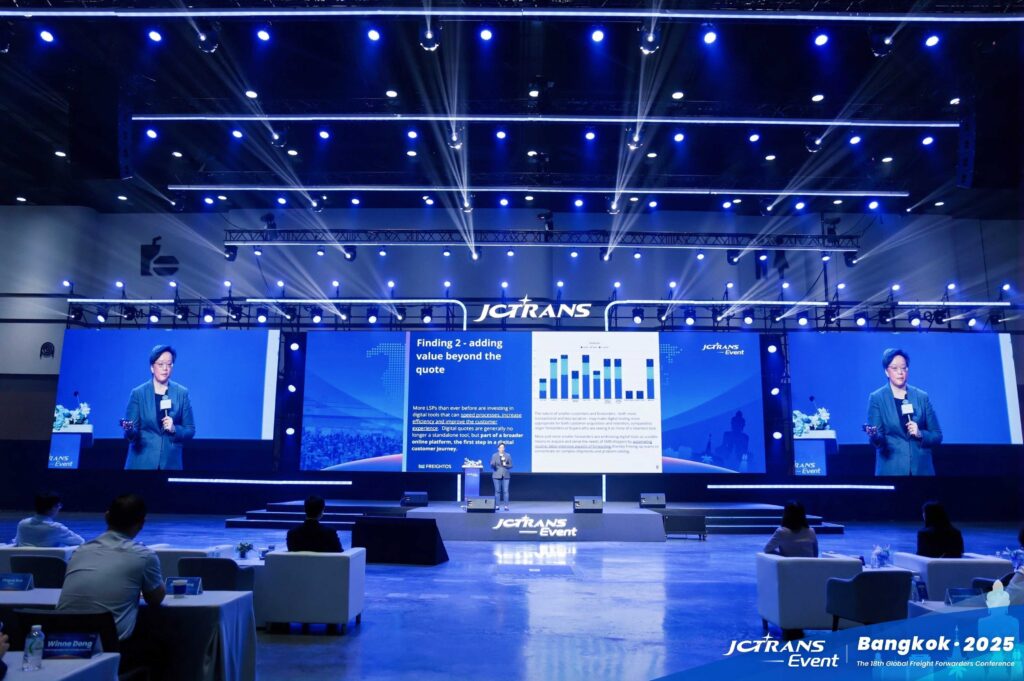For years, the freight industry has flirted with digital transformation, promising instant quotes, frictionless bookings, and an Amazon-like experience for shippers. The assumption? That digital freight sales would be a magic bullet for customer acquisition, pulling in new business with the ease of an e-commerce checkout.
But here’s the plot twist: digital sales aren’t just about winning new customers anymore – they’re about keeping them.
At JCtrans, the 18th Global Freight Forwarders Conference, I shared the latest findings from Freightos’ mystery shopping survey, which assessed how forwarders and carriers are actually using digital tools. Spoiler alert: quoting has gone mainstream, but in an industry that still thrives on relationships, many forwarders are putting up digital velvet ropes. Instead of offering instant rates to just anyone, nearly half of logistics service providers (LSPs) keep their quoting tools gated – available only to vetted customers.

Gatekeeping Instant Quoting: Why Forwarders Are Keeping Rates Locked Down
A decade ago, instant freight quoting was a fantasy. The Freightos’ 2021 State of Digital Freight report reveals that in 2015, not a single major forwarder or carrier could offer an online quote in real time. Now, instant quoting is the norm – if you know the right people.
- Six of the top 20 forwarders now provide instant LCL ocean freight quotes, up from just four in 2021.
- When including gated instant quoting tools, nearly half of the top forwarders offer instant quotes – but many only after an application process that sometimes involves a friendly phone call, a bit of paperwork, and possibly a secret handshake.
- Four of the five largest ocean carriers have also implemented instant quoting, though most require shippers to go through an approval process first.
Clearly, the technology is there. The hesitation? Forwarders don’t want to become the Travelocity of freight.
For years, the industry feared that online price transparency would lead to a cutthroat race to the bottom. Instead of a tech-driven utopia, many worried they’d be left competing on razor-thin margins, while customers used their quotes as leverage in endless price wars.
So, what happened? Instead of opening the floodgates, many forwarders have wrapped digital quoting in layers of relationship-building, ensuring that those who get access are likely to stick around.
This makes sense in a world where customers still value reliability over rock-bottom rates. Mark Chadwick, President of the Global Shippers Association for GE Health, put it perfectly:
Technology should make the shipper-LSP relationship smoother, but it can’t waive a surcharge or get your cargo on an overbooked plane.
Or, in simpler terms: an algorithm can’t charm a port official into letting your container onto a full ship.
Beyond the Quote: Digital Freight’s Real Power Move
If forwarders aren’t just using digital tools to grab new business, what are they doing? They’re using them to lock in long-term customers with an increasingly seamless digital experience.
The best forwarders understand that digital quoting isn’t a stand-alone feature – it’s the entry point into a full-service, tech-driven customer journey.
- 80% of forwarders with instant quoting now enable online booking – because why stop at the quote when you can close the deal?
- More than 80% offer tracking and shipment management after booking, because customers like to see their cargo moving (or at least know why it isn’t).
- 92% provide digital insurance options; 83% offer customs services.
- Some are rolling out premium features like guaranteed delivery dates and CO2 offsets, proving that digital freight isn’t just about price – it’s about control.
Kuehne + Nagel, for example, now offers an interactive map to help shippers plot their origin and destination visually, while Maersk has introduced rollable container discounts and additional D&D (detention and demurrage) time for those who like a little flexibility. UPS, always thinking ahead, has even thrown in real-time pricing surveys and promo codes to keep things interesting.
And this is where things get exciting. The most forward-thinking LSPs aren’t just automating quoting – they’re making digital freight a premium, value-added service. They’re not just handing out rates; they’re offering a better, faster, and more transparent way to ship.
Digitization for Forwarders: It’s Easier Than You Think
For those still skeptical about digitization, here’s the good news: it doesn’t have to be a multi-year transformation project requiring a tech army. There’s a simple, structured way to integrate digital tools without losing the human touch that makes freight forwarding work.
Step 1: Improve Efficiency by Digitizing Rates and Rate Distribution
The first step is getting your rates online – not buried in spreadsheets or locked away in emails. Forwarders that digitize their rates can instantly share them across their internal teams and external partners, making pricing accessible without manual lookups or constant back-and-forth.
Step 2: Reduce the Contact-to-Order Ratio with Rate Sharing and eBooking Delegation
Once rates are digitized, the next step is to enable easy access and booking. By configuring business rules and allowing teams and partners to self-serve quotes and eBook shipments, forwarders can dramatically cut the time it takes to go from inquiry to order. Instead of waiting on manual approvals, bookings happen faster, reducing friction and improving conversion rates.

Step 3: Enable a Seamless Digital Booking Experience
Think like a digital carrier – whether through API integration or simple Excel uploads, forwarders can ensure that rates and schedules are instantly available for booking. The best forwarders don’t just show pricing; they provide real-time capacity, direct booking access, and automated confirmations – ensuring a frictionless experience for customers.
Step 4: Enable Cross-Border eBookings with Digital Payments
A seamless digital booking experience isn’t complete without an efficient payment flow. With solutions like WebCargo Pay, forwarders can offer secure, flexible payment options, making it easier to do business across borders. Carriers retain full control over who can book, while reducing banking fees and unlocking new business opportunities.
By following these four steps, forwarders can transform their sales process, improve efficiency, and scale their digital operations – all while keeping relationships at the heart of their business.
What About Smaller Forwarders? Digital Sales as a Growth Strategy
For global players, digital quoting has become a retention tool. But for smaller forwarders, it’s still a powerful acquisition strategy.
Unlike the giants, who can afford to keep their best digital tools behind closed doors, smaller forwarders can use instant quoting as a competitive advantage.
- It lowers customer acquisition costs by making it easier to bring in new business without a lengthy sales process.
- It levels the playing field against bigger competitors by automating manual processes.
- It creates upsell opportunities by allowing forwarders to bundle services like insurance, customs clearance, and premium transit options.
For SMBs, digital freight isn’t just about convenience – it’s about survival in an increasingly competitive market.
The Big Picture: Digital Freight is About Relationships, Not Just Technology
After analyzing the latest mystery shopping survey, one thing is clear: digital freight sales aren’t turning this industry into a price-driven, transactional market. Instead, forwarders are using technology to build stickier, more valuable customer relationships.
- Instant quoting is now widespread – but nearly half of LSPs keep it gated for existing customers.
- 80%+ of digital forwarders offer full shipment management after quoting.
- The best forwarders aren’t just providing rates – they’re offering increased visibility, and seamless payment solutions, as well as using digital tools to bundle high-value, specialized services that give customers more control, flexibility, and reliability in their shipments. These services go beyond price and focus on customer experience, efficiency, and added value.
- Smaller forwarders can still use digital sales for acquisition, but they need to automate routine processes to stay competitive.
Technology is making freight more efficient, but it’s not replacing the human relationships that drive this business. The smartest forwarders aren’t choosing between digital and personal service – they’re using digital to enhance it.


